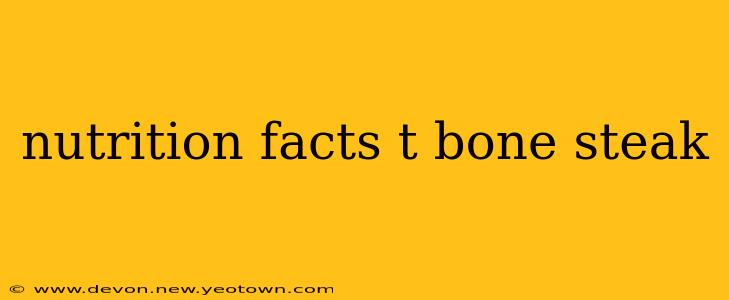The aroma of sizzling T-bone steak, its rich marbling promising a juicy, flavorful experience, is enough to make anyone's mouth water. But beyond the culinary delight, lies a nutritional profile that's as robust as its taste. Let's delve into the fascinating world of T-bone steak nutrition facts, exploring its benefits, potential drawbacks, and answering some frequently asked questions.
Imagine this: you're at a high-end steakhouse, the waiter presents the menu, and your eyes land on the majestic T-bone. You know it’s a treat, but what exactly are you getting nutritionally? Let’s unpack that.
What are the nutrition facts of a T-bone steak?
A typical 3-ounce serving of a T-bone steak (about the size of a deck of cards) boasts a nutritional powerhouse. The exact numbers can fluctuate based on the cut, the animal's diet, and the marbling, but generally, you're looking at:
- Protein: A significant source, providing approximately 20-25 grams per serving. This is crucial for building and repairing tissues, supporting a healthy immune system, and keeping you feeling full and satisfied.
- Iron: T-bone steak is an excellent source of heme iron, the type your body absorbs most efficiently. This is particularly important for preventing iron-deficiency anemia.
- B Vitamins: These are essential for energy production, nerve function, and cell growth. You'll find a good dose of B vitamins, including B12, in your T-bone.
- Zinc: Important for immune function, wound healing, and cell growth.
- Selenium: An antioxidant that plays a role in protecting your cells from damage.
How many calories are in a T-bone steak?
The caloric content of a T-bone steak varies greatly, depending on the size and the amount of fat. A 3-ounce serving can range from 150 to 250 calories, with a higher fat content naturally leading to more calories. Choosing leaner cuts and trimming visible fat can help keep calorie intake in check.
Is T-bone steak good for weight loss?
This is a complex question. While T-bone steak is packed with protein, which can aid in weight management by promoting satiety, the higher fat content can hinder weight loss efforts if consumed in excess. Moderation is key. Incorporating T-bone steak as part of a balanced, calorie-controlled diet, along with regular exercise, can be part of a successful weight loss strategy. However, relying on it as a primary weight loss tool is unlikely to yield optimal results.
What are the potential downsides of eating T-bone steak?
While undeniably nutritious, there are some potential downsides to consider:
- High in Saturated Fat: T-bone steak, particularly the more marbled cuts, is relatively high in saturated fat, which can contribute to high cholesterol levels if consumed excessively. Balance is vital.
- High in Cholesterol: Like other red meats, T-bone steak is naturally higher in cholesterol compared to leaner protein sources like poultry or fish. Individuals with high cholesterol should exercise caution and moderation in their consumption.
- Potential for Carcinogens: As with other red meats, some research suggests a possible link between high red meat consumption and an increased risk of certain cancers. This is an area of ongoing research, and moderation remains the key takeaway.
How can I prepare a healthy T-bone steak?
Preparing a healthy and delicious T-bone steak involves smart choices:
- Trim Visible Fat: Before cooking, trim away excess visible fat to reduce the overall fat content.
- Choose Leaner Cuts: Opt for T-bone steaks with less marbling if possible.
- Healthy Cooking Methods: Grill, bake, or broil your steak instead of frying, which adds extra fat.
- Portion Control: Stick to recommended serving sizes (approximately 3 ounces).
- Balance Your Meal: Pair your T-bone steak with plenty of non-starchy vegetables for a more balanced and nutritious meal.
In conclusion, the T-bone steak offers a delicious and nutritious experience, but like any food, moderation and mindful consumption are essential. By making informed choices regarding preparation and portion size, you can enjoy the benefits of this culinary delight while minimizing any potential downsides. Remember to consult with a healthcare professional or registered dietitian for personalized dietary advice, especially if you have any underlying health conditions.

